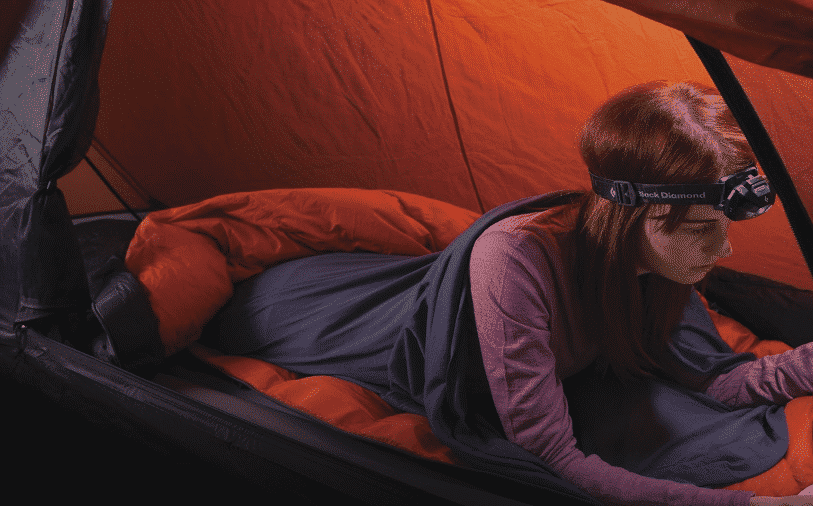Sleeping bag liners are easily the most undervalued piece of camping gear. It’s really hard to quantify just how nice liners are without actually trying one. They’re lightweight, protect your sleeping bag, fight off bugs and add extra warmth to your bag.
How to Choose a Sleeping Bag Liner
With so many options available how do you choose a sleeping bag liner? It all boils down to how much warmth do you want to get out of your liner. Do you want a lightweight liner designed for the summer or thermal/flannel liner that will give you 12°-24°+ of additional warmth? You might even be able to use your thermal liner instead of a sleeping bag.
Do you actually need a sleeping bag liner?
So do you actually need a sleeping bag liner? Just think about it logically. Do you sleep in your bed without sheets? I hope not! Sleeping bag liners protect your bag just like sheets protect your mattress.
Whether or not you should actually buy a liner depends on the price of your bag and how often you plan on using it. It really doesn’t make sense to protect a $20 Walmart bag with a $60 liner. On the other hand with an expensive down sleeping bag, you’ll definitely want to protect your investment.
Why Use a Sleeping Bag Liner?
Although sleeping bag liners aren’t entirely necessary they do have lots of advantages. Cutting costs and shedding weight are the only two reasons why somebody wouldn’t use a liner.
Considering silk liners(like this one) only weigh like 4oz and compact down to the size of a cell phone they really don’t weigh all that much. Plus I can usually ditch my sleeping bag in the summer and replace it with my Sea to Summit Reactor Liner (On Amazon) which adds 24° of warmth to my bag.
Here are more reasons why you should use a sleeping bag liner
So why use a sleeping bag liner?
- Protect Your Bag From Damage: Sleeping bag liners protect your bag from dirt, sweat and body oils that would otherwise damage your bag. Every single time you wash your sleeping bag the filling compresses and becomes less effective.
- Basic Hygiene: After a long day of hiking do you really want to get into your sleeping bag covered in dirt and sweat? All that sweat and dirt will quickly start to buildup causing allergies and general nastiness.
- Liners are Easier to Wash: Every time you wash your sleeping bag you risk tearing it and compressing the insulation. Plus sleeping bags take forever to get fully dry. On the other hand, sleeping bag liners can be washed just like any other set of sheets.
- Add Versatility to Your Sleeping Bag: With a thermal sleeping bag liner(like this one) you can use a 3-Season bag well into winter. In the summer thermal liners can even be used in place of a sleeping bag. That’s what I call versatility.
- Add Additional Warmth: You’ll have extra warmth with every additional layer you put between your body and the outside air. Even cheap liners like the Coleman Fleece Liner(On Amazon) add 12° of warmth to your sleeping bag. I highly recommend Sea to Summits Thermal Sleeping Bag liners if you plan on camping in cold weather.
Different Sleeping Bag Liner Styles
Most backpackers, campers and hostel travelers have some familiarity with sleeping bag liners. Even if you’ve never used one you probably get why they’re useful. When first looking at liners you’ll probably notice that they usually come in 2 basic styles.
- Mummy shaped liners are obviously designed to fit mummy-style sleeping bags. Just slip the liner in your bag and you’re good to go.
- Rectangular liners(travel sheets) are very popular in the overseas backpacking communities. They are designed for use on their own or with a rectangular sleeping bag.
Aside from the regular liner styles you also have couple liners and silk liners designed to fight against bed bugs.
Check out this post for more information on silk sleeping bag liners.
Getting Extra Warmth From Your Sleeping Bag Liner

The amount of warmth you get from your liner will largely depend on the material it’s made out of (continue reading below to learn about different materials). Generally speaking, most people are referring to insulated and fleece liners when talking about the added warmth.
For more info check out my post on liner warmth
With a budget fleece liner (like this one) you will typically get 12° of additional warmth which is perfect for mild spring and fall chill. If you plan on doing winter camping you’ll want an insulated liner.
Sea to Summit is by far my favorite manufacturer of sleeping bag liners. My Reactor Extreme Liner (On Amazon) adds 25° of warmth to my bag without causing me to sweat like crazy.
Different Liner Materials
You’re really going to need to look at the material your liner is made of before making a purchasing decision. Thermal liners tend to offer the most versatility since they can be used on their own in the summer and extend your bags temperature rating in the winter.
Check out my post on different sleeping bag liner materials for more information.
- Thermal Liners (Expensive): Thermal liners are by far the warmest liners on the market. They can add 25°+ degrees of warmth to your bag. They are highly breathable and soft with the only downside being additional weight.
- Fleece and Microfleece( Mid Price): Fleece and microfleece liners add a lot of warmth at an affordable price tag. Products like Colemans Fleece Liner add a lot of warmth at an affordable price tag.
- Synthetic (Mid Price): Synthetic liners are used primarily in the warmer months because of their moisture-wicking properties. They are usually made out of polyester, elastic or neoprene blends making them lightweight and breathable.
- Microfibre: (Cheap) Ever buy microfiber bed sheets? That’s basically what you’re getting with a microfiber liner. They provide some warmth(not much), they’re lightweight and cheap.
- Cotton: (Cheap) Personally I’m not a huge fan of cotton bag liners. Just like cotton sheets, these are going to absorb sweat and stain easily. After a long hike on the trail, you’re going to be sweaty so you’ll end up with yellow stains in no time.
- Silk: (Mid Price) Silk liners are used primarily in the traveling and ultralight communities(weigh about 4oz). Although primarily used by travelers to fight against bed bugs they also work with mosquitos, ticks, ants, fleas, chiggers and midges.



